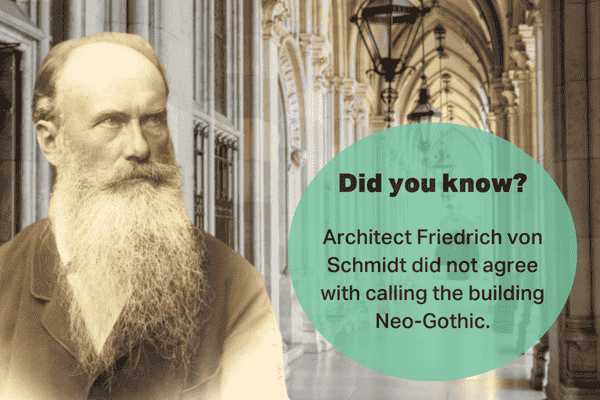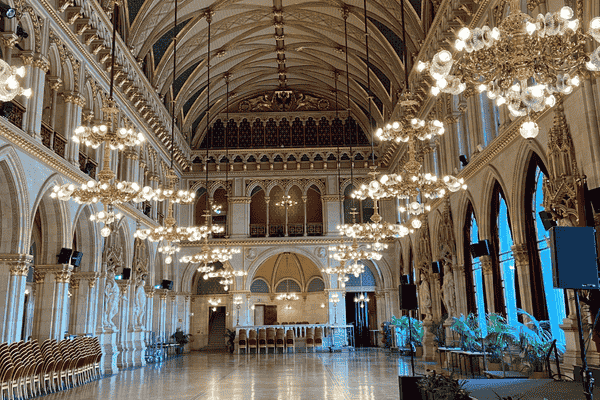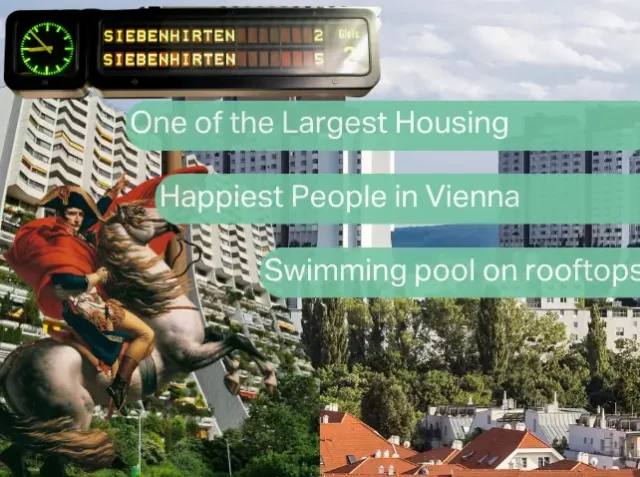Vienna City Hall (Wiener Rathaus) is full of fascinating history and unique features. Below are some interesting facts that highlight the rich past and cultural significance of this iconic building.

Book
Austria by Public Transport
Discover Austria like never before with “Austria by Public Transport.” This book is your ultimate guide to exploring the beauty of Austria easily and affordably. Get your copy today and start your adventure!
Vienna City Hall (Wiener Rathaus), also known as the New Rathaus, is a shining example of Neo-Gothic architecture.

The building hosts Vienna’s key officials, including the Mayor and Vienna State Parliament members. This Rathaus is among Vienna’s most famous landmarks and attracts many visitors.
Vienna City Hall
(Wiener Rathaus)
Vienna’s City Hall connects closely with the city’s growth and the creation of the Ringstrasse. In the 19th century, Vienna’s population surged, leading to overcrowding. Emperor Franz Joseph II saw the need for more space, so he removed the old city walls, which limited Vienna’s size and even posed security risks. Construction of the Rathaus began during this transformation, and architect Friedrich von Schmidt completed it in 1883. Builders sourced materials from Austria and abroad to keep up with the high demand, adding an international touch.
Gallery

Vienna City Hall
illuminated at night

Christmas Market
with festive decorations

Vienna City Hall
Council Chamber

Inside Vienna City Hall
Detailed view of the decor

The Grand Ballroom
with magnificent chandeliers

Rathaus
The grand staircase

Subscribe
Explore Vienna like a local and discover nearby treasures.
Join our mailing list!
‘Fooled’ the Emperor
Emperor Franz Joseph I ordered that the Rathaus tower should not exceed the Votivkirche’s height of 99 meters, as it symbolized the power of God and the Habsburgs. The architect respected this request and designed the Rathaus tower at 98 meters. Yet, to cleverly meet the Emperor’s wish while adding height, he placed a statue over 5 meters tall on top of the 98-meter tower.
Architecture of Vienna City Hall (Wiener Rathaus)
The central tower, topped with the famous Rathausmann statue, catches every visitor’s eye.

Inside, you’ll find some of Vienna’s largest ballrooms. The building’s facade displays statues of Austrian rulers like Emperor Franz Joseph I, along with figures representing strength, justice, and traditional trades.
Neo-Gothic Style
- Slim, soaring shapes – Neo-Gothic buildings have tall, slim towers and strong supports, giving them a light and elegant look.
- Pointed arches – Neo-Gothic architecture includes sharp, pointed arches, which create a sense of height and energy.
- Decorated facades – These buildings show rich details, like tracery, rosettes, and decorative cornices, adding a mysterious and elegant charm.
- Stained glass – Brightly colored stained glass windows with intricate patterns bring a spiritual feel, inspired by Gothic cathedrals.
Place of Events
In front of the Rathaus, a large square opens up for lively festivals, markets, and events. Along the main avenue leading from the Burgtheater to City Hall, statues of important Austrians line the way, adding to the cultural atmosphere.
| Aspect | Gothic | Neo-Gothic |
|---|---|---|
| Era of Development | Emerged in the Middle Ages (12th–15th centuries), evolving from Romanesque style. Built to inspire spirituality and awe. | Revival in the 19th century during the Romantic period, representing nostalgia for the Middle Ages. |
| Technology and Materials | Relied on traditional techniques using stone, with complex buttresses and arch systems for support. | Used newer materials like steel and cast iron, allowing taller, more decorative structures with less effort and cost. |
| Symbolism and Function | Primarily religious, with tall cathedrals and religious symbols to bring people closer to God. | Focused on aesthetics and nostalgia, often used in secular buildings like universities, city halls, and homes. |
| Architectural Details | Handcrafted details, including tracery, rosettes, and statues of saints, adding intricate beauty. | Often used mass-produced ornaments, more symbolic and decorative, sometimes with less detail. |
From the start, planners designed Vienna City Hall as a place for public gatherings. They included several entrances and elegant staircases to welcome both locals and tourists.

How to Visit
1. Guided Tours
- Schedule: Mondays, Wednesdays, and Fridays at 1:00 PM
- Ticket Collection: Pick up tickets on the day of the tour at 8:00 AM from the Tourist Information desk (rear entrance).
- Audio Guide: Available in English with a photo ID deposit.
- Tip: Arrive at least 15 minutes before ticket distribution during the tourist season to ensure punctuality.
2.Library
- Experience: Step back in time in one of Austria’s largest libraries.
- Registration: Tours are not regularly scheduled; advance registration is enough to secure a visit.
After World War II damaged the building, officials quickly worked to restore it. Between 2012 and 2023, they cleaned the facade to restore its beauty fully.
Interesting Facts
Historical Highlights
- The oldest tree in Rathaus park is a plane tree planted in 1783.
- During the Nazi era, the square in front of City Hall was called Adolf-Hitler-Platz.
- Until 1960, the building was officially known as the New Rathaus.
- Vienna’s first historical mayor, Konrad Poll, lived from 1240 to 1305.
- A beech tree planted in 1896, marking Emperor Franz Joseph I’s 50-year reign, still stands in Rathaus park.
- Vienna’s Christmas Market tradition dates back to 1296, making it the oldest Christmas market in the world.
Architectural Features
- The Rathausmann statue is modeled after Emperor Maximilian I.
- The statues in front of City Hall originally stood at Karlsplatz on the Elisabeth Bridge.
- Inside, the building has Austria’s largest historical-style hall.
- The arcaded courtyard inside City Hall ranks among the largest in Europe.
- City Hall has its own fire brigade, independent from the state fire service – the oldest fire service in the world.
- A unique “cooling system” in City Hall uses fresh air from Rathaus park to keep certain rooms cool.
Events and Culture
- The Christmas Market in front of City Hall is one of Europe’s largest and most beautiful.
- Since 1996, a seasonal ice rink operates near City Hall in winter, one of the largest mobile ice rinks in Europe.
Planning and Location
- The Rathaus was initially planned to be built near Stadt Park but was moved to a more prestigious location after lobbying by the Mayor.
- Outside the city walls once lay a large open area known as the “Vienna Glacier” (Wiener Glacis), a 450-meter zone for city defense.
- Covering 14,000 square meters, City Hall is the largest building on the Ringstrasse.
Political and Civic Facts
- In Vienna, EU citizens who live in the city can vote in local district elections, though the Mayor is not directly elected by the public.
Join Our Vibrant Community
Are you passionate about discovering the hidden gems of Vienna and its surroundings? Follow us on social media and become part of our enthusiastic community!
Why Follow Us?
- Exclusive Content: Each post is a labor of love, taking between 10-30 hours to create. We share breathtaking photos, captivating stories, and invaluable tips.
- Stay Updated: Never miss out on exciting events, new attractions, and must-visit spots in and around Vienna.
- Support Independent Projects: We are an independent project, and your follows help us cover the costs of running this page. Your support is crucial!
Your Support Matters!
Every follow, like, and share directly supports our work. It helps us continue bringing you the best content and ensures we can keep this site running. By following us, you’re not just staying informed – you’re helping us grow and thrive.
Don’t miss out! Click the links above and start following us today. We can’t wait to connect with you!





